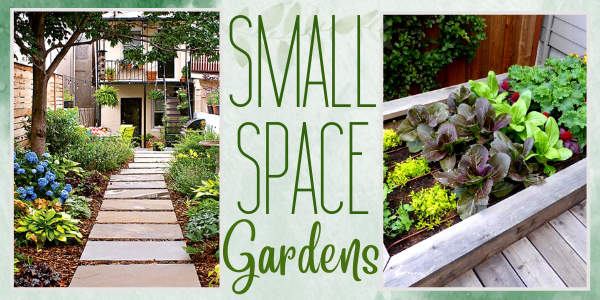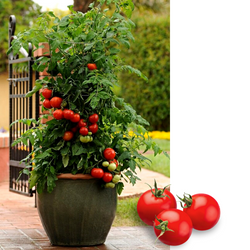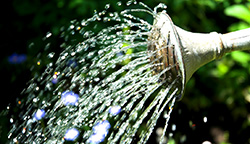
Do you dream of stepping out the back door in the summer to harvest your own homegrown vegetables for meals? Maybe you visualize long rows of spinach, corn, beans, and squash. Or maybe your dream is a flower garden with plenty of colors, textures, and fragrance. If you’ve got more dreams than space, that doesn’t mean you can’t have a garden! With a little know-how and some creative thinking, you can still harvest fresh homegrown veggies this summer and have some beautiful flower combinations too!

The Advantages of Container Gardening
Simply put, container gardens are small, portable gardens that can be placed almost anywhere. They’re perfect for patios, porches, and balconies — even along stairs!
Even those who have larger garden areas can use containers to add a touch of color to areas where it may be difficult to grow flowers in the ground. You can easily add a few pots of flowers around your raised vegetable beds to attract more essential pollinators to your food crops too!
These small, portable gardens offer so many conveniences. For example, you might add a few containers of tomatoes, lettuces, or herbs to a handy sunny spot on the patio. It’ll save a trip out to the raised beds to harvest this summer’s salads.
Hate weeding? Container gardens are easily accessible, and they’ll require little, if any weeding! Summer storm or early/late season frosts threatening your garden? You can easily move your containers to a protected spot until the weather sorts itself out. Have problems with animals raiding your strawberry patch? Plant them in a hanging basket instead! With the exception of crops like larger pumpkins or corn, you’ll find you can grow nearly anything in a container!
Containers offer so much versatility to your gardening choices, and they’re easier to put together than you think! There are just a few steps to keep in mind, and then you’ll be up and growing in no time!
Step One – Determine the Available Sun in Your Space
Whether you’re gardening in a large space or a small one, every gardener starts in the same place — how much sun do have available? It’s important because that will determine what plants will grow best in the space you have.

You’ll want to keep sun requirements (especially for vegetables!) in mind. Full Sun means 6 or more hours of direct sun on your plants per day. Partial Sun/Partial Shade is 4-6 hours of direct sun per day, and Full Shade is less than 4 hours of direct sun a day.
Most veggies require 6-8 hours of sun per day. Look for a space that meets that sun requirement. Tomatoes, peppers, and cucumbers all want plenty of summer sun to produce their best. Flowers like geraniums, petunias, and African daisies will thrive in a sunny space too.
If your garden space only receives partial sun (4-6 hours per day), choose from a different plant palette. Veggies like lettuce, radishes, kale, and Swiss chard will grow fine with partial sun or filtered sun conditions. Flowers such as fuchsia, begonias, impatiens, and coleus need protection from midday sun and will provide plenty of bold color in your shadier garden spaces.

Step Two – Choose a Container
There is no shortage of choices for gardeners when it comes to containers for patios, decks, and porches. There are pots in everything from terracotta and recycled ocean plastics to glazed ceramics and even cloth! They’re all available in a seemingly unlimited number of colors and sizes.
Think about using vertical options like window boxes that fit over deck railings, or hanging baskets that will allow you to extend your gardening space upwards. Adding trellises to your pots will allow you to grow vining flowers and veggies in a smaller space.
Make sure whatever container you choose has drainage holes in the bottom, and will be large enough to provide adequate space for roots and soil, which will allow your container garden to grow and thrive.
Step Three – Add Soil
Good things grow from good soil! Like planting in a raised bed, container gardening requires a light, porous soil that will allow for good drainage.

We like Nature’s Yield Outdoor Planter Mix for containers. It’s blended with sphagnum peat moss for added moisture retention. To save on the amount of soil needed for a taller pot, use an Ups-A-Daisy insert (located in our indoor container area). It sits about 10-12″ from the top of the container, effectively raising the bottom of the pot. This reduces the weight of the containers, and helps ensure essential oxygen will reach to the lower plant roots.

Step Four – Choose Your Plants
Specialized varieties have been developed for small-space gardeners. When choosing plants look for terms like “compact,” “tidy plant habit,” or “short stature” on plant tags and seed pack descriptions.
We make it easy for you to choose plants. Our shade-loving plants are all on the north side of the greenhouse, while sun-lovers are on the south side. You can always find the sun requirement icons on our signs.
For a floral planter, follow the easy design “recipe” used by the pros: think thriller, filler, spiller. It makes plant choices easy! Choose a thriller, that is a tall plant such as dracaena spikes or maybe an ornamental grass. For your filler element, choose plants that mound like petunias, geraniums, or coleus. Finally, for something that “spills” out over the sides, think lobelia, sweet potato vine, or creeping Jenny.
For a container vegetable garden, tomatoes and peppers are favorites for patio pots, along with fresh herbs and salad veggies. Choose determinate varieties of tomatoes. They stay shorter. Add a trellis or stake to your container for growing peas, cucumbers, and mini pumpkins!
Step Five – Watering and Fertilizing Your Container Garden
When gardening in pots, remember that potted plants need a little different care than their counterparts in the ground.

The soil dries out more rapidly in containers, so keep an eye on them and make sure they’re well watered and fertilized. We like Jack’s Classic Blossom Booster for floral pots and Jack’s All Purpose or Tomato Feed for veggie containers.
In the heat of summer, check your container gardens in the morning and the afternoon to see if they need watering. Adding a polymer like Soil Moist will help retain water in the soil.
Since container gardens are watered more often, fertilizer will get flushed from the soil faster than an in-ground garden. The nutrients your plants will need to grow and thrive should be added on a regular basis.
That’s it! In just a few simple steps you’ll be growing lush, vibrant container gardens of your own. A garden doesn’t have to cover a large area to be beautiful and enjoyable. It’s just a matter of making the best use of the space you have. Whether you decide to plant a few fresh veggies on the patio or create an abundant floral display for the front porch, get your hands in the soil and have fun with gardening in containers this summer!